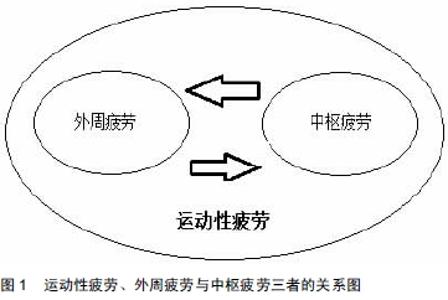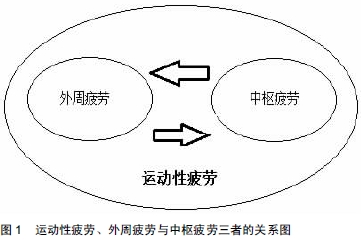Chinese Journal of Tissue Engineering Research ›› 2015, Vol. 19 ›› Issue (42): 6849-6854.doi: 10.3969/j.issn.2095-4344.2015.42.023
Previous Articles Next Articles
Re-cognition of exercise-induced central and peripheral fatigue
Tian Feng
- Guangzhou Sport University, Guangzhou 510500, Guangdong Province, China
-
Online:2015-10-08Published:2015-10-08 -
About author:Tian Feng, Master, Lecturer, Guangzhou Sport University, Guangzhou 510500, Guangdong Province, China
Cite this article
Tian Feng. Re-cognition of exercise-induced central and peripheral fatigue[J]. Chinese Journal of Tissue Engineering Research, 2015, 19(42): 6849-6854.
share this article
| [1] 刘庆山,姜慧,樊云彩. 躯体性疲劳机制研究的进展与思考[J].南京体育学院学报自然科学版,2003,2(1):11-16; 43. [2] 王静,刘洪涛,马强,等.运动性中枢疲劳时大鼠脑乳酸和糖原含量的变化[J]. 中国运动医学杂志,2005,24(2):152-155. [3] Westerblad H, allen DG. Changes of intracellular pH due to repetitive stimulation of single fibers from mouse skeletal muscle. J Physiol Lond.1992;(449):49-71. [4] Edman KA. Changes in force and stiffness induced by fatigue and intracellular acidification in frog muscle fibers.J Physil Lond.1993;(424):133-149. [5] Metzger JM.pH modulation of the kinetics of a casensitive cross-bridge state transition in mammalian single skeletal muscle fibers.J Physiol Lond.1990; (428):751-764. [6] Bertocci LA, Fleckenstein JL, Antonio J. Human muscle fatigue after glycogen depletion: a 31P magnetic resonance study. J Appl Physiol.1992;73: 75-81. [7] 田野.运动性疲劳的机理研究[M].北京:人民体育出版社,1997. [8] Leppik JA, Aughey RJ, Medved I, et al.Prolonged exercise to fatigue in humans impairs skeletal muscle Na+-K+-ATPase activity, sarcoplasmic reticulum Ca2+ release, and Ca2+ uptake. J Appl Physiol.2004;97: 1414-1423. [9] Gasser RN,Vaughan-Jones RD. Mechanism of potassium efflux and action potential shortening during ischaemia in isolated mammalian cardiac muscle.J Physiol Lond.1990;431: 713-741. [10] Gramolini A,Renaud JM. Blocking ATP-sensitive K+ channel during metabolic inhibition impairs muscle contractility. Am J Physiol Cell Physiol.1997;272: C1936-C1946. [11] Hodgkin AL,Horowicz P. The influence of potassium and chloride ions on the membrane potential of single muscle fibres. J Physiol Lond.1959;148: 127-160. [12] Bickham DC. Extracellular K accumulation:a physiological tramework for fatigue cluring intense exercise.J Physiol. 2004;554(3):593. [13] Van Lunteren E, Moyer M.. Effects of DAP on diaphragm force and fatigue, including fatigue due to neurotransmission failure. J Appl Physiol.1996;81(5): 2214-2220. [14] Byrd S, Bode A, Klug G. Effect of exercise of varying duration on sarcoplasmic reticulum function. J Appl Physiol. 1989; 66(3):1383-1389. [15] Favero TG. Sarcoplasmic reticulum Ca2+ release and muscle fatigue. J Appl Physiol.1999;87(2): 471-483. [16] Germinario E,Esposito A,Megighian A,et al.Effects of modulators of sarcoplasmic Ca2+ release on the development of skeletal muscle fatigue. J Appl Physiol. 2004;96: 645-649. [17] Allen DG, Westerblad H. Role of phosphate and calcium stores in muscle fatigue. J Physiol. 2001;536(3);657-665. [18] Gyorke S. Effects of repeated tetanic stimulation on excitation contraction coupling in cut muscle fibres of the frog. J Physiol Lond. 1993;464: 699-710. [19] Westerblad H, Lee JA, Lännergren J, Cellular mechanisms of fatigue in skeletal muscle.Am J Physiol.1991;261(Cell Physiol. 30): C195-C209. [20] Guter TE,Pfeiffer DR. Mechanisms bu which mitochondria transport calcium.Am J Physiol.1990;258(5 Pt 1):C755-86 [21] Lew H,Pyke S, Quintanilha A. Changes in the glutathione status of plasma, liver and muscle following exhaustive exercise in rats. FEBS Lett. 1985;185(2):262-266. [22] Kretzschmar M, Muller D, Hubscher J,et al.Influence of aging, training and acute physical exercise on plasma glutathione and lipid peroxides in man. Int J Sports Med.1991;12(2): 218-222. [23] Ríos E, Ma JJ, González A. The mechanical hypothesis of excitation contraction Coupling in skeletal muscle. J Muscle Res Cell Motil.1991;(12): 127-135. [24] Newsholme EA, Blomstrand E.Branched-Chain Amino Acids and Central Fatigue. American Society for Nutrition J. Nutr. 2006;136:274S-276S. [25] Eva Blomstrand.A Role for Branched-Chain Amino Acids in Reducing Central Fatigue . American Society for Nutrition J. Nutr. 2006;136:544S-547S. [26] Davis JM, Alderson NL, Welsh RS. Serotonin and central nervous system fatigue: nutritional considerations.Am J Clin Nutr.2000;72(suppl):573S–578S. [27] Decombaz J, Reinhardt P, Anantharaman K, et al. Biochemical changes in a 100 km run: free amino acids ,urea , and creatinine. Eur J Appl Physiol.1979; 41:61-72. [28] Keast D, Arstein D, Harper W, et al. Depression of plasma glutamine after exercise stress and its possible influence on the immune system. Med J Aust. 1995; 162:15–18. [29] 章江州.芳香族氨基酸对运动性疲劳的影响[J].中国运动医学杂志,1991,10(4):229. [30] Kingsbury KJ, Kay L, Hjelm M. Contrasting plasma free amino acid patterns in elite athletes: association with fatigue and infection.Br J Sports Med. 1998;32:25-33. [31] Nishigaki Y , Bonilla E, Shanske S,et al. Exercise-induced muscle ‘burning’ fatigue, and hyper-CKemia: mtDNA T10010C mutation in tRNAGly. American Academy of Neurology. 2002;58:1282-1285. [32] Piacentini MF, Meeusen R, Buyse L,et al. Hormonal responses during prolonged exercise are influenced by a selective DA/NA reuptake inhibitor. Br J Sports Med. 2004;38:129-133. [33] Baily SP,Davis JM,Ahlborn EN .Neuroendocrine and substrate responses toaltered brain 5-HT activity during prolonged exercise to fatigue.J Appl Physiol. 1993; 76(6):3006-3012. [34] Tanaka M,Nakamura F,Mizokawa S. et al .Establishment and assessment of a rat model of fatigue.Neurosci Lett.2003; 352(3):159-162. [35] Fitts RH. Cellular mechanisms of muscle fatigue. Physiol Rev. 1994;74: 49-94. [36] Weir JP, Beck TW, Cramer JT,et al.Is fatigue all in your head? A critical review of the central governor model. Br J Sports Med. 2006;40(7):573-586; discussion 586. [37] Amann M, Eldridge MW, Lovering AT,et al.Arterial oxygenation influences central motor output and exercise performance via effects on peripheral locomotor muscle fatigue in humans. J Physiol.2006;575(3):937-952. [38] Kent-Braun JA, Ng AV, Doyle JW, et al. Human skeletal muscle responses vary with age and gender during fatigue due to incremental isometric exercise. J Appl Physiol. 2002; 93:1813-1823. [39] 张力为.心理学研究的七个方向:以运动性心理疲劳为例[J]. 体育科学,2010,30(10) :3-11. [40] 李小华.运动疲劳与恢复的生理过程研究[J].福建体育科技, 2011,(4):30-31. [41] 杨涛.合理营养补充,有效缓解运动疲劳[J].中国学校体育, 2013, (1):82. [42] 户丽,张红林,图娅,等.近5年针灸推拿消除运动性疲劳研究进展[J]. 针灸临床杂志, 2012,28(1):69. [43] 刘建宇,刘黎明,李广周,等.经穴推拿抗运动性疲劳的实验研究[J].中国体育科技,2012,48(1):141-144. [44] 邓嘉. 田径运动训练中运动性疲劳与恢复理论的研究[J]. 科技资讯,2011,(10):220-221. [45] 孙国晓,张力为. 自我决定动机影响运动员心理疲劳:横向与纵向研究的证据[J]. 体育科学,2013,33(7):21-28. [46] 刘方琳,张力为. 运动员心理疲劳的定性探索[J].体育科学,2004, 24(11):37-44. [47] 金湖,吴家舵.关于运动性心理疲劳的研究概况[J].体育科研, 2006, 26(3):36-38. [48] 赵茜,张力为.教练员心理疲劳的特征及相关因素[J].体育科学, 2007,27(12):38-39. |
| [1] | Xie Wenjia, Xia Tianjiao, Zhou Qingyun, Liu Yujia, Gu Xiaoping. Role of microglia-mediated neuronal injury in neurodegenerative diseases [J]. Chinese Journal of Tissue Engineering Research, 2021, 25(7): 1109-1115. |
| [2] | Xie Zhifeng, Liu Qing, Liu Bing, Zhang Tao, Li Kun, Zhang Chunqiu, Sun Yanfang. Biomechanical characteristics of the lumbar disc after fatigue injury [J]. Chinese Journal of Tissue Engineering Research, 2021, 25(3): 339-343. |
| [3] | Jiang Xiaoyan, Zhu Haifei, Lin Haiqi, Lin Wentao. Cold therapy promotes self-limited recovery of delayed-onset muscle soreness [J]. Chinese Journal of Tissue Engineering Research, 2021, 25(23): 3609-3613. |
| [4] | He Lin, Wu Xi, He Song, Yang Sen. Hydrophilicity and cell adhesion of hydroxyapatite bioceramics after the coating of polydopamine [J]. Chinese Journal of Tissue Engineering Research, 2021, 25(22): 3540-3544. |
| [5] |
Cao Sucheng, Xu Xiaofeng, Chen Qi, Lu Hao, Wang Zhe, Zhang Rui, Wang Yao, Zhang Zhijian, Yang Wenjing.
Sonic hedgehog-polydopamine-fibrin scaffold promotes recovery of spinal cord injury in rats [J]. Chinese Journal of Tissue Engineering Research, 2020, 24(28): 4567-4572. |
| [6] | Zhao Jing. Effects of Tai Chi Chuan on the changes of bone mineral density of perimenopausal women [J]. Chinese Journal of Tissue Engineering Research, 2020, 24(2): 176-180. |
| [7] | Liu Yang1, 2, 3, Wang Dexin1, 3, Cheng Lifen2, Huang Zhongwei4, Chen Zhiyong1, 5, Li Lei2. Visualization analysis of Citespace V on sports fatigue protocols from the perspective of sports biomechanics [J]. Chinese Journal of Tissue Engineering Research, 2019, 23(27): 4291-4299. |
| [8] | Xu Wen, Qian Yu, Yin Jin . Changes of cardiac function and myocardial apoptosis regulatory factors in rat models of excessive fatigue [J]. Chinese Journal of Tissue Engineering Research, 2019, 23(19): 3074-3079. |
| [9] | Chen Li, Hu Lan, Peng Yanan, Yang Liu, Shen Hui, Wang Tan, Zhao Zhenqiang. Differentiation of human pluripotent stem cells into dopaminergic neurons: security risk for heterogeneity [J]. Chinese Journal of Tissue Engineering Research, 2019, 23(1): 118-124. |
| [10] | Lu Xiao-feng, Ling Li, Dong Ning. Influence of arch curvature and all-ceramic materials on fatigue life of fixed bridges: a finite element analysis [J]. Chinese Journal of Tissue Engineering Research, 2018, 22(14): 2174-2178. |
| [11] | Zhu Yu-zhen, Zhang Qing-wen. Molecular dynamics simulation: a new direction targeting physiological mechanisms of neuronal calcium sensor-1 protein [J]. Chinese Journal of Tissue Engineering Research, 2017, 21(20): 3224-3233. |
| [12] | Zhang Miao, Zhang Xu-ran, Li Rui, Sun Yu. Dopamine and 5-hydroxytryptamine signaling pathways in the pathogenesis of spinal cord injury-induced osteoporosis: new theory and novel therapeutic strategies [J]. Chinese Journal of Tissue Engineering Research, 2016, 20(51): 7731-7737. |
| [13] | Wu Ya-dan, Liang Pei-ri, Long Deng-yi, Gao Bing-miao. Effects of Ginkgo biloba Pingchan Recipe on loss and apoptosis of dopamine neurons in mouse models of Parkinson’s disease [J]. Chinese Journal of Tissue Engineering Research, 2016, 20(49): 7327-7333. |
| [14] | Qian Yu, Yin Wei-yao, Li Hua. Changes of thyroid and cardiac function in exercise-induced sudden death model rats after excessive fatigue [J]. Chinese Journal of Tissue Engineering Research, 2016, 20(49): 7356-7363. |
| [15] | Xiong Sheng, Chen Xi-liang, Wang Yun-feng, Hu Yong. Optimization design and simulation analysis of artificial atlanto-odontoid joint structure [J]. Chinese Journal of Tissue Engineering Research, 2016, 20(48): 7169-7174. |
| Viewed | ||||||
|
Full text |
|
|||||
|
Abstract |
|
|||||

